Hillsborough: Straw blames Thatcher for police 'impunity'
- Published
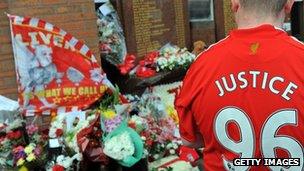
Ninety-six Liverpool football fans died after a crush at Sheffield Wednesday's ground on 15 April 1989
Ex-Home Secretary Jack Straw has said Margaret Thatcher's government created a "culture of impunity" in the police that led to the Hillsborough cover-up.
An independent report accused the South Yorkshire Police of deflecting blame for the disaster on to innocent fans.
But Labour's Mr Straw said the then Conservative government was complicit because they needed "partisan" support from the police.
Senior Conservatives dismissed the claims as "very silly" and "wrong".
Mr Straw said that it was "a matter of great regret" to him that Labour had not ensured that the disaster had been investigated thoroughly enough earlier in its time in office, between 1997 and 2010.
But he also told BBC Radio 4's Today programme: "The Thatcher government, because they needed the police to be a partisan force, particularly for the miners strike and other industrial troubles, created a culture of impunity in the police service.
"They really were immune from outside influences and they thought they could rule the roost and that is what we absolutely saw in south Yorkshire."
Mellor 'disappointed'
But Lord Tebbit, one of Baroness Thatcher's closest political allies, said Mr Straw's remarks were "just very, very silly".
It was "nonsense" to claim that the Thatcher government was ready to turn a blind eye to police conduct, he said.
David Mellor, another former Conservative cabinet minister, said Mr Straw's remarks were "wrong" and "disappointing".
"I'm astonished that he should divert attention away from what we should really be talking about today, which is how we bring to book those police officers who perverted the course of justice by altering the statements of their colleagues," he said.
"I was a Home Office minister for five years in the 1980s, I took through Parliament the Police and Criminal Evidence Act, the first time tape recorders and microphones were introduced in police stations to ensure that the police could not fit up defendants by inventing confessions.
"Our conscience is very clear on the police."
Labour shadow cabinet member Andy Burnham, who commissioned the Hillsborough report, praised the prime minister's statement in the Commons on Wednesday, and said he did not want to make political points.
Asked about Mr Straw's comments, he said that "everyone has questions to answer, ourselves included".
"The welfare, safety, of ordinary people was cast aside as some very heavy-handed approaches to policing were adopted," he told the BBC.
"Everyone needs to have an open discussion about how this culture of negligence, the sheer mendacity of the police force in pursuing the victims and survivors of that tragedy, how on earth as a society we ever let that happen."
Ninety-six Liverpool fans, external died after a crush on overcrowded terraces at Sheffield Wednesday's ground during the FA Cup semi-final between Liverpool and Nottingham Forest in April 1989.
An independent report found some of the 96 might have been saved and said police had changed witness statements to blame Liverpool fans for the disaster.
The report, external was compiled by the Hillsborough Independent Panel, which had scrutinised more than 450,000 pages of documents over the past 18 months.
Following its publication, David Cameron apologised to victims' families for the "double injustice", which he said was both in the "failure of the state to protect their loved ones and the indefensible wait to get to the truth", and in the efforts to denigrate the deceased and suggest that they were "somehow at fault for their own deaths".
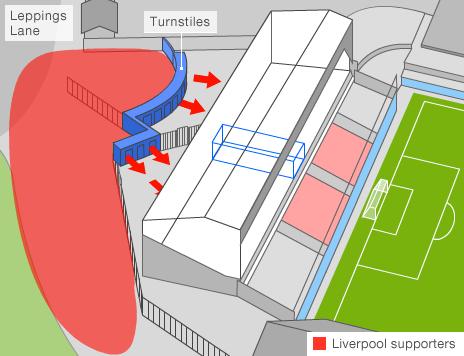
1430-1440: Several thousand Liverpool supporters are gathered outside the ground at the Leppings Lane end. Decrepit turnstiles mean admission to the ground is slow.
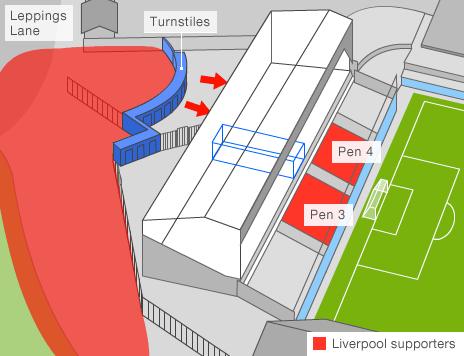
1450: Pens 3 and 4 on the stand's lower terrace are full. Their official combined capacity was 2,200, though it is later discovered this should have been reduced to 1,600 as crush barriers did not meet official standards.
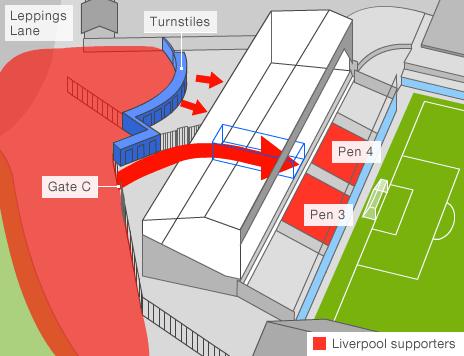
1452: Police order Gate C - a large exit gate - to be opened to alleviate the crush outside the ground. Around 2,000 supporters enter the ground and make for a tunnel leading directly to pens 3 and 4.
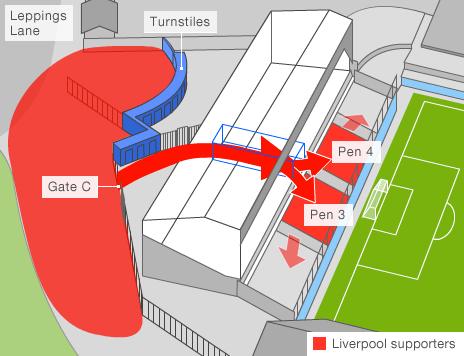
1459: The influx of fans caused severe crushing in pens 3 and 4. Fans begin climbing over fences to escape. It is later estimated that more than 3,000 supporters were admitted to the central pens, almost double the "safe" capacity.
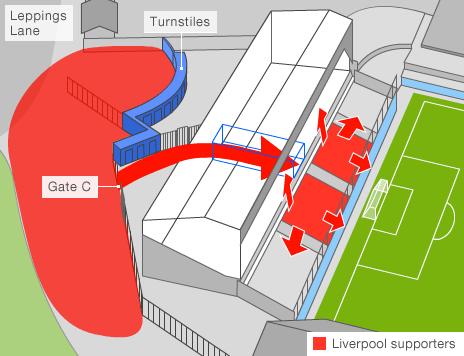
1500: Match kicks off. Five minutes later, a crush barrier inside pen 3 give way, causing people to fall over. Supporters climb perimeter fences or are dragged to safety by fans in the stand's upper tiers.
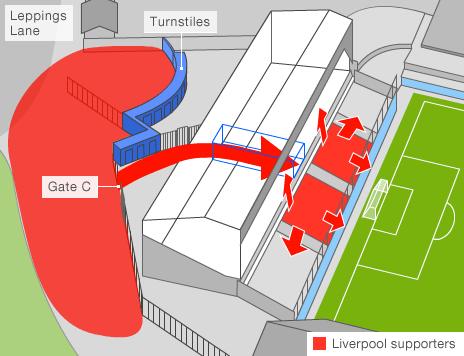
1506: Match stopped by referee. Some 730 people are injured, 96 fatally. In the chaotic aftermath, supporters desperately try to resuscitate the injured.